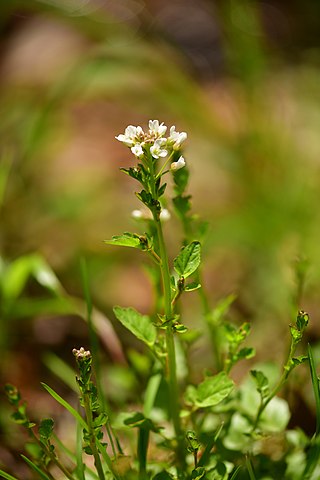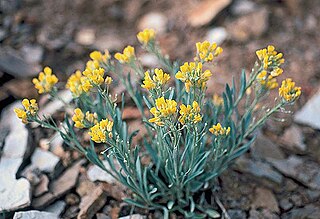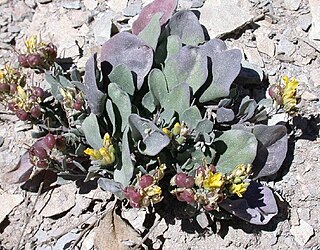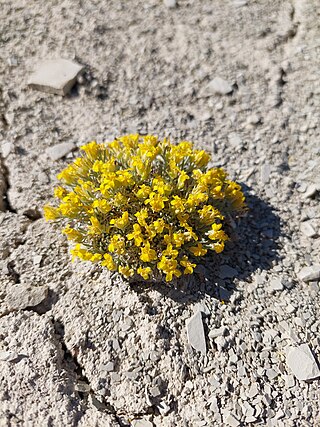
Physaria fendleri is a species of flowering plant in the family Brassicaceae known by several common names, including Fendler's bladderpod, popweed, and lesquerella.

Physaria is a genus of flowering plants in the family Brassicaceae. Many species are known generally as twinpods, bladderpods, or lesquerella. They are native to the Americas, with many species endemic to western North America. They are densely hairy annual and perennial herbs often growing prostrate or decumbent, along the ground in patches or clumps. They bear inflorescences of bright yellow flowers. The fruit is often notched deeply, dividing into twin sections, giving the genus its common name.

Cardamine micranthera is a rare species of flowering plant in the mustard family known by the common names small-anthered bittercress and streambank bittercress. It is endemic to the Piedmont region around the border between Virginia and North Carolina, and is today restricted to the Dan River watershed. It is in decline mainly because its habitat has been disturbed and destroyed by a number of processes. By the 1960s the only known populations of the plant had disappeared and in the 1970s it was feared extinct. The plant was rediscovered in the 1980s and for a while was presumed to be a rare North Carolina endemic; populations in Virginia have been confirmed since. The plant was federally listed as an endangered species in 1989 when it was known from only four tiny populations on unprotected private land. Today there are about 32 occurrences; one occurrence in North Carolina has been extirpated and five others there had no specimens found at the most recent survey.
Paysonia perforata, known by the common name Spring Creek bladderpod, is a rare species of flowering plant in the mustard family. It is endemic to Tennessee in the United States, where it is known only from Wilson County. This very rare plant is threatened by the loss and degradation of its habitat. It is federally listed as an endangered species.

Physaria filiformis is a rare species of flowering plant in the family Brassicaceae known by the common names Missouri bladderpod and limestone glade bladderpod. It is native to Missouri and Arkansas in the United States. It was federally listed as an endangered species in 1987 and it was downlisted to threatened status in 2003. P. filiformis remains listed as an endangered species at the state level in Missouri.

Physaria obcordata is a rare species of flowering plant in the family Brassicaceae known by the common name Dudley Bluffs twinpod. It is similar in appearance to the more common Piceance twinpod, but can be distinguished by looking at the leaves through a hand lens. The Piceance twinpod, Physaria acutifolia has stellate hairs when viewed through a hand lens while Physaria ocordata has markings that look like a satellite dish, or a circle with a dot in the middle. It is endemic to Colorado, where it is found only in the Piceance Basin in Rio Blanco County. It is threatened by the loss and degradation of its habitat. It is a federally listed threatened species of the United States.

Sidalcea nelsoniana is a rare species of flowering plant in the mallow family known by the common names Nelson's checkerbloom and Nelson's checkermallow. It is native to the Willamette Valley and Coast Range of Oregon and the southwestern corner of Washington in the United States. It is threatened by the destruction and degradation of its habitat, and it is a federally listed threatened species of the United States.
Physaria hemiphysaria is a species of flowering plant in the mustard family known by the common names Intermountain bladderpod and skyline bladderpod. It is endemic to Utah in the United States, where it grows on rocky ridges and outcrops of sandstone, shale, clay, and sand.
Physaria parviflora is a species of flowering plant in the family Brassicaceae known by the common names Piceance bladderpod and frosty bladderpod. It is endemic to Colorado in the United States, where it occurs in Garfield, Mesa, and Rio Blanco Counties.
Physaria fremontii is a species of flowering plant in the family Brassicaceae known by the common name Fremont's bladderpod. It is endemic to Wyoming in the United States, where it occurs only in and around the Wind River Range in Fremont County.

Physaria tenella is a species of flowering plant in the family Brassicaceae known by the common names Moapa bladderpod and slender bladderpod. It is native to western North America from Utah to Sonora, where it grows mainly in desert habitat. This is an annual herb producing several hairy multibranched erect to spreading stems sometimes exceeding half a meter long. The basal leaves are up to 6.5 centimeters long and sometimes toothed, and there are smaller leaves higher on the stem. The inflorescence is a raceme of flowers at the tip of the stem. The mustardlike flower has four orange to bright yellow petals each up to a centimeter long. The fruit is a plump, hairy, rounded capsule containing flat orange seeds.
Leavenworthia crassa is a species of flowering plant in the mustard family, Brassicaceae, known commonly as the fleshy-fruit gladecress. It is endemic to Alabama in the United States, where it occurs in only two counties. It is "likely one of the most imperiled plant species in the Southeast," and the United States Fish and Wildlife Service issued a final rule listing it as an endangered species in 2014.

Physaria pallida is a rare species of flowering plant in the mustard family known by the common name white bladderpod. It is endemic to Texas in the United States, where it is known only from San Augustine County. It is federally listed as an endangered species.

Physaria congesta is a rare species of flowering plant in the mustard family known by the common name Dudley Bluffs bladderpod. It is endemic to western Colorado in the United States, where it is known only from seven occurrences in Rio Blanco County. It is federally listed as a threatened species.

Physaria kingii is a species of flowering plant in the family Brassicaceae known by the common name King bladderpod. It is native to western North America from Utah to Baja California, where it grows in dry and rocky habitat, such as deserts and adjacent mountain slopes. This is a perennial herb growing a small, hairy stem from a caudex. The leaves form a patch or rosette around the caudex, each up to 6 centimeters long and round, oval, diamond, or spoonlike in shape. The inflorescence is an erect or mostly upright raceme of bright yellow mustardlike flowers. The fruit is a hairy capsule under a centimeter long suspended on a short, often curvy pedicel.

Physaria parvula is a species of flowering plant in the family Brassicaceae known by the common name pygmy bladderpod. It is native to the Western United States, where it can be found in Colorado, Utah, and Wyoming.

Physaria pruinosa is a species of flowering plant in the family Brassicaceae known by the common names Pagosa Springs bladderpod and frosty bladderpod. It is native to Colorado and New Mexico in the United States.

Physaria thamnophila is a rare species of flowering plant in the mustard family known by the common name Zapata bladderpod. It is native to Texas in the United States, where it is known from Zapata and Starr Counties. The plant is threatened by the loss and degradation of its habitat. It is federally listed as an endangered species.

Physaria tumulosa, known by the common name Kodachrome bladderpod, is a rare species of flowering plant in the family Brassicaceae. It is endemic to Utah in the United States, where it is known only from Kane County. There is only one known population of this plant, made up of scattered occurrences totaling about 20,000 individuals, all within the Kodachrome Basin. The plant is threatened by the loss and degradation of its habitat. It is federally listed as an endangered species. It was previously treated as a subspecies of Physaria hitchcockii.

Physaria ludoviciana is a species of flowering plant in the mustard family Brassicaceae, with the common names of bladder pod, silver bladderpod, louisiana bladderpod, and foothill bladderpod. It used to be Lesquerella ludoviciana which is now a synonym.
















